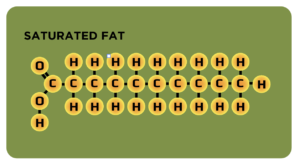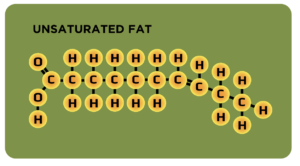The Chemistry of Fats
We previously read that fats can be categorized into three types: the good, the bad, and the ugly.
Let’s look at the chemical structure of fat molecules to learn more. (Don’t panic – there will not be a test!)
To put it simply, fat molecules are like chains made up of carbon atoms linked together.Each carbon atom has 4 “bonding sites” where they can attach to other atoms. On those sites, they bond with another carbon atom or a hydrogen atom. (There are more details about the carboxyl group at the end and more, but just trying to give the “need-to-know” info to explain the major stuff)
 When all these spaces are filled up, the molecule is full – or “saturated” – and it forms a straight line. From life experience, you probably know that it is easier to stack up things that are flat and similar, right? Well, the same applies to tiny molecules. These can stack on each other easily – forming a solid mass of molecules – like coconut oil, butter, ghee, and fat marbles in meat. Therefore, this type of fat is called “saturated.”
When all these spaces are filled up, the molecule is full – or “saturated” – and it forms a straight line. From life experience, you probably know that it is easier to stack up things that are flat and similar, right? Well, the same applies to tiny molecules. These can stack on each other easily – forming a solid mass of molecules – like coconut oil, butter, ghee, and fat marbles in meat. Therefore, this type of fat is called “saturated.”
 Moving on, the “unsaturated fats” are formed similarly, but they switch it up a little and have a weaker double bond thrown in there between the carbon atoms. This acts like a spring, which would make it more pliable and moves more freely and forms a liquid. This spring-like bond makes the unsaturated fat less stable. When a fat molecule has a SINGLE double bond, it is called “monounsaturated” with mono meaning one. So, when there are two or more, the prefix poly- is used, creating the term “polyunsaturated.” You can imagine trying to stack something with multiple springs that won’t lay out properly. The more double bonds a fat contains, the less stable it becomes.
Moving on, the “unsaturated fats” are formed similarly, but they switch it up a little and have a weaker double bond thrown in there between the carbon atoms. This acts like a spring, which would make it more pliable and moves more freely and forms a liquid. This spring-like bond makes the unsaturated fat less stable. When a fat molecule has a SINGLE double bond, it is called “monounsaturated” with mono meaning one. So, when there are two or more, the prefix poly- is used, creating the term “polyunsaturated.” You can imagine trying to stack something with multiple springs that won’t lay out properly. The more double bonds a fat contains, the less stable it becomes.
This is a lot of information, but, believe me, it will all come together.
So, examples of monounsaturated fats are: olive oil, cashews, avocados, peanuts, macadamia nuts, canola oil, almonds, sesame seeds, pecan, and hazelnuts. (These are your omega 9s, which are named for where the first double bond forms)
Polyunsaturated fats are: things like sunflower oil, flaxseed oil, grapeseed oil, soybean oil, safflower, cottonseed, sunflower, corn, vegetable oil, etc. Also falling in this category are things like: Fatty, cold-water fish like tuna, salmon, mackerel, sardines, eggs, pumpkin seeds, hemp seeds, hemp oil, flax seeds, chia seeds, and poultry. (These are Omega-3s and Omega-6s)
Now, this may paint a very confusing picture. We hear we need Omega-3 and Omega-6 essential fatty acids (EFAs), yet we know some of those oils listed are NOT healthy, AND we know that flax, hemp, and chia seeds are healthy, yet they are in the same category. Well, what gives?
Like the grains we learned about, these oils come in a complete little package, thanks to nature. When consumed before they are processed, (as found in nature), they are typically healthy, as we know when we eat raw pumpkin seeds and raw sunflower seeds. It is when we interfere and chemically process these oils that the problem occurs.
Here, we run into the issue of rancid oils which will be covered in our post about how cooking oils are processed.


